How Do I Seal Floor Registers?
If you have not sealed the ductwork in your heating and cooling system properly, you are wasting a lot of money, trying to keep your home warm or cool. The floor registers are often the most overlooked part of the ductwork even though they are notorious for leaking around the edges. Duct tape will not do the job either. A study conducted by the Lawrence Berkeley National Laboratory demonstrated that duct tape simply does not stand up very long against the temperatures in a heating or cooling system. The market does provide an alternative that works, not just on floor registers, but also for all your ductwork.

-
Clean the floor register by picking it up out of the floor and dusting it off with a dry cloth. Dip your washcloth into the bucket of soap and water and wash the register down to remove any dirt or reside. Dry the register completely with a towel.
-
Apply the nontoxic duct sealing mastic around all the edges on the underside of the register with the paintbrush and drop the register back into place. Press down firmly to form a seal with the floor beneath. Apply the mastic, using the brush, around the edges where the register meets the floor to strengthen the bond. As an option, you can cut strips of fiberglass mesh tape long enough to cover the sides of the register and apply the fiberglass mesh tape along the edges so that it bonds with the duct-sealing mastic for a more durable hold.
-
Test the seal of the floor register by turning on your system and using the fan on your system to blow air through the ductwork. Feel around the edges of the register to make sure no more air escapes around the edges.
References
Tips
- You should also check all other ductwork in the home and seal all connections using the same steps described for the floor registers. If you cannot access some of your ductwork, contact a contractor who can perform the work for you.
- Once you seal your floor registers, you should use a vacuum cleaner to keep the registers free of dust on a regular basis.
Writer Bio
Kenneth W. Michael Wills is a writer on culture, society and business. With more than 15 years of experience in sales, public relations and written communications, Wills' passion is delighting audiences with invigorating perspectives and refreshing ideas. He has ghostwritten articles on a diverse range of topics for corporate websites and composed proposals for organizations seeking growth opportunities.
Photo Credits
- register close up image by Ray Kasprzak from Fotolia.com
More Articles



